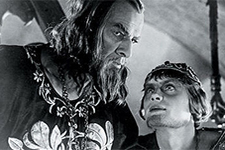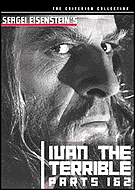Ivan the Terrible Part I / Part II [DVD]
|

German philosopher Friedrich Nietzsche wrote that we "explain the past only by what is most powerful in the present." The same is also true in reverse, that we explain the present only by what is most powerful in the past, which is the case of Soviet director Sergei Eisenstein's Ivan the Terrible, an epic cinematic portrait of Tsar Ivan IV, who was the first ruler to unite the various Russian states and principalities in the 16th century. Ivan the Terrible was first proposed by Soviet dictator Joseph Stalin, who wanted to recuperate the tsar as a great leader and one of his historical forerunners. Ivan IV had been responsible for some important reforms in Russia during his reign, but he was known primarily as a cruel dictator who devolved into paranoia, violence, and insanity. Many still find it odd that Stalin would chose Ivan IV for this project, but it makes sense in that they are both men cut from the same mold, and Stalin probably assumed that, if Ivan's reputation could be recuperated, his own tyranny would be more accepted (the final years of his rule, from 1945 to 1953, when Ivan the Terrible was made, were some of Stalin's most excessive). Eisenstein, who had fallen out of favor with Stalin's regime in the 1930s but had re-established himself with the nationalistic masterpiece Alexander Nevsky in 1938, accepted the project with vigor and enthusiasm. Yet, he did not produce the ideological-historical revisionism that Stalin was looking for. Rather than a recuperation of Ivan the Terrible, Eisenstein produced a brilliant cinematic work that was a thinly veiled portrait of not only Stalinism at its worst, but also the failed Bolshevik Revolution of which Eisenstein had been a part. Ivan the Terrible is a complex study of the nuances of power, how it functions within tyranny, and the process by which it changes hands. Ivan the Terrible Part I was released in 1945, and Stalin was so pleased with it, that he bestowed on it the Stalin Award, the highest honor it could receive. The critique of Stalinism was too apparent in Ivan the Terrible Part II, however, and Stalin had it banned (it was never shown publicly until 1958). Eisenstein had written a script and shot about four reels of Ivan the Terrible Part III, which would have completed the trilogy, but persistent health problems and Stalin's political censorship conspired to ensure that it would never be completed. Ivan the Terrible Part II would be his final film. Ivan the Terrible Part I begins in 1547 with Ivan (Nikolai Cherkassov, who also played the lead in Alexander Nevsky) being crowned tsar of Russia in a lavish ceremony. His coronation is staunchly opposed by the boyars, wealthy families of noble lineage who do not want their power and wealthy minimized by an all-powerful ruler. As Ivan the Terrible Part I shows, however, opposition and treachery do not reside only in obvious enemies. In somewhat Shakespearean fashion, Ivan will fall victim to his own best friends and most trusted advisors, which adds to the sense of paranoia and distrust that pervades the second half of his rule. What makes Ivan the Terrible Part I tragic is that Ivan appears to have good intentions at the beginning, when he is a young man still full of hope and potential. Yet, as the axiom goes, absolute power corrupts absolutely, and Ivan is no different. As the film progresses, he becomes more and tyrannical in his hunger for power and his desire to ensure the realization of the abstract "Great Russian State," which he refers to as "the third Rome." Accordingly, his physical portrayal becomes more and more grotesque. Once a handsome young man, by the end of the film he is a caricature of malevolence, thin and pointed at all ends, from his hawk nose to his long, sharp beard. Eisenstein emphasizes his separation from humanity by constantly focusing on his shadow, which is cast in disproportionate excess against the walls around him, seeming to literally swallow up all who come into his presence. Despite the obvious critique of the hunger for absolute power inherent in Ivan the Terrible Part I, it is not hard to see why Stalin would have viewed it so approvingly. One can almost imagine him nodding his head in agreement when Ivan's doomed wife, Anastasia (Ludmila Tselikovskaya), declares to the boyars, "Once you have rejected individual authority, no matter how strong, courageous, intelligent you may be, your government will be directionless." A strong argument for a dictator, no doubt, and that is likely as deep as Stalin was willing to read, which rendered him unable to see Eisenstein's deeper meanings. This is perhaps most telling at the end of the film, when the people of Russia line up to beg Ivan to return to power in Moscow. On a purely narrative level, this appears to reassert the need for a dictator to rule the state and to justify all of Ivan's excesses in pursuit of working for, as he puts it, "the future of the Great Russian State." Yet, look at how Eisenstein frames these scenes, with Ivan in the extreme foreground and the faceless people relegated to the far background, where they are dominated by Ivan's presence. At one point, Eisenstein gives us an extreme close-up of Ivan in profile looking downward, his sharp face and long beard forming a frame of domination within which the background masses are trapped. In Ivan the Terrible Part II, which was filmed at the same time as Part I and edited a month later, much of the plot revolves around a conspiracy by the boyars to assassinate Ivan (the film is also known as The Boyars' Plot). Stalin immediately banned the film upon seeing it because he felt it cut a little too close to the bone, especially in its focus on the oprichniki, Ivan's personal bodyguards who were obviously analogous to the secret police Stalin used in the late 1930s to purge the Soviet Union of all who doubted him. Part II is even more paranoid than Part I, with its swirling conspiracies, plots, and betrayals. The film also includes a crucial flashback sequence that was originally intended to be the opening part of Ivan the Terrible Part I, but was cut because Stalin demanded it. This flashback shows Ivan as a young boy witnessing the death of his mother by poisoning at the hand of boyars, his being crowned Duke of Moscow, and the first time he uses the force of violence to assert his authority. This sequence is of absolute importance because it establishes Ivan's psychological framework and why his hatred of the boyars is so intense. The look on young Ivan's face after he orders his first execution is absolutely chilling in the way it depicts the boy realizing what he is capable of. Although Ivan sinks deeper into madness and paranoia in Part II, the childhood flashback gives him a more humane dimension and underscores Eisenstein's assertion that Ivan is not evil, as many have tried to read him. Rather, he is a flawed man whose good intentions ran aground on his own desire for grandiosity.
Copyright © 2001 James Kendrick |
||||||||||||||||||||||||||||||||||||||||||||||||||||
Overall Rating:



 (3.5)
(3.5)
Subscribe and Follow
Get a daily dose of Africa Leader news through our daily email, its complimentary and keeps you fully up to date with world and business news as well.
News RELEASES
Publish news of your business, community or sports group, personnel appointments, major event and more by submitting a news release to Africa Leader.
More Information
